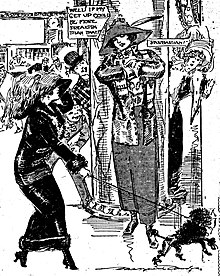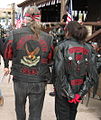
Goth is a music-based subculture that began in the United Kingdom during the early 1980s. It was developed by fans of gothic rock, an offshoot of the post-punk music genre. Post-punk artists who presaged the gothic rock genre and helped develop and shape the subculture include Siouxsie and the Banshees, Bauhaus, the Cure, and Joy Division.

The punk subculture includes a diverse and widely known array of ideologies, fashion, and other forms of expression, visual art, dance, literature, and film. Largely characterised by anti-establishment views, the promotion of individual freedom, and the DIY ethics, the culture originated from punk rock.
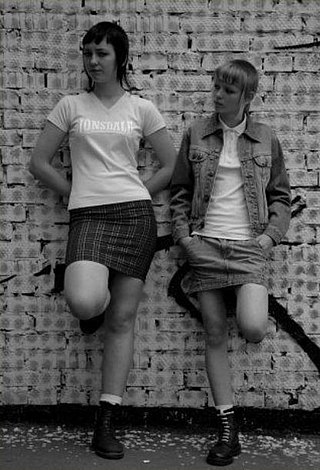
A skinhead or skin is a member of a subculture that originated among working-class youths in London, England, in the 1960s. It soon spread to other parts of the United Kingdom, with a second working-class skinhead movement emerging worldwide in the late 1970s. Motivated by social alienation and working-class solidarity, skinheads are defined by their close-cropped or shaven heads and working-class clothing such as Dr. Martens and steel toe work boots, braces, high rise and varying length straight-leg jeans, and button-down collar shirts, usually slim fitting in check or plain. The movement reached a peak at the end of the 1960s, experienced a revival in the 1980s, and, since then, has endured in multiple contexts worldwide.
Gothic rock is a style of rock music that emerged from post-punk in the United Kingdom in the late 1970s. The first post-punk bands which shifted toward dark music with gothic overtones include Siouxsie and the Banshees, Joy Division, Bauhaus, and the Cure.

Gothic fashion is a clothing style worn by members of the goth subculture. A dark, sometimes morbid, fashion and style of dress, typical gothic fashion includes black dyed hair and black clothes. Both male and female goths can wear dark eyeliner, dark nail polish and lipstick, and dramatic makeup. Styles are often borrowed from the Elizabethans and Victorians. BDSM imagery and paraphenalia are also common. Gothic fashion is sometimes confused with heavy metal fashion and emo fashion.
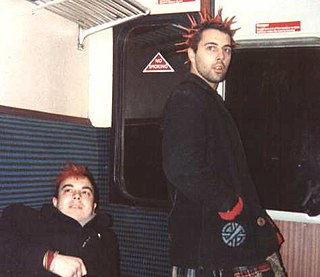
Punk fashion is the clothing, hairstyles, cosmetics, jewellery, and body modifications of the punk counterculture. Punk fashion varies widely, ranging from Vivienne Westwood designs to styles modeled on bands like The Exploited to the dressed-down look of North American hardcore. The distinct social dress of other subcultures and art movements, including glam rock, skinheads, greasers, and mods have influenced punk fashion. Punk fashion has likewise influenced the styles of these groups, as well as those of popular culture. Many punks use clothing as a way of making a statement.

A subculture is a group of people within a cultural society that differentiates itself from the conservative and standard values to which it belongs, often maintaining some of its founding principles. Subcultures develop their own norms and values regarding cultural, political, and sexual matters. Subcultures are part of society while keeping their specific characteristics intact. Examples of subcultures include BDSM, hippies, hipsters, goths, steampunks, bikers, punks, skinheads, gopnik, hip-hoppers, metalheads, cosplayers, otaku, otherkin, furries, and more. The concept of subcultures was developed in sociology and cultural studies. Subcultures differ from countercultures.
A rivethead or rivet head is a person associated with the industrial dance music scene. In stark contrast to the original industrial culture, whose performers and heterogeneous audience were sometimes referred to as "industrialists", the rivethead scene is a coherent youth culture closely linked to a discernible fashion style. The scene emerged in the late 1980s on the basis of electro-industrial, EBM, and industrial rock music. The associated dress style draws on military fashion and punk aesthetics with hints of fetish wear, mainly inspired by the scene's musical protagonists.
The 20th century saw the rise and fall of many subcultures.
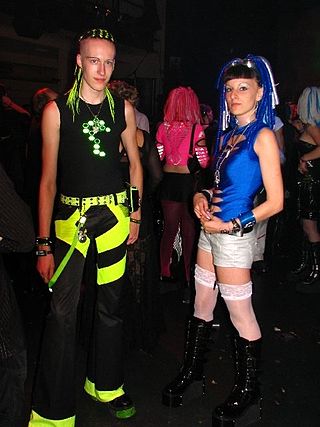
Cybergoth is a subculture that derives from elements of goth, raver, rivethead and cyberpunk fashion.

Lolita fashion is a subculture from Japan that is highly influenced by Victorian clothing and styles from the Rococo period. A very distinctive property of Lolita fashion is the aesthetic of cuteness. This clothing subculture can be categorized into three main substyles: 'Gothic', 'Classic', and 'Sweet'. Many other substyles such as 'Sailor', 'Country', 'Hime' (princess), 'Guro' (grotesque), 'Qi' and 'Wa', 'Punk', 'Shiro' (white), 'Kuro' (black), and 'Steampunk' Lolita also exist. This style evolved into a widely followed subculture in Japan and other countries in the 1990s and 2000s and may have waned in Japan as of the 2010s as the fashion became more mainstream.
Japanese street fashion refers to a number of styles of contemporary modern clothing in Japan. Created from a mix of both local and foreign fashion brands, Japanese street fashions tend to have their own distinctive style, with some considered to be extreme and avant-garde, with similarities to the haute couture styles seen on European catwalks.

Youth subculture is a youth-based subculture with distinct styles, behaviors, and interests. Youth subcultures offer participants an identity outside of that ascribed by social institutions such as family, work, home and school. Youth subcultures that show a systematic hostility to the dominant culture are sometimes described as countercultures.

Fashion of the 1980s was characterized by a rejection of 1970s fashion. Punk fashion began as a reaction against both the hippie movement of the past decades and the materialist values of the current decade. The first half of the decade was relatively tame in comparison to the second half, which was when apparel became very bright and vivid in appearance.
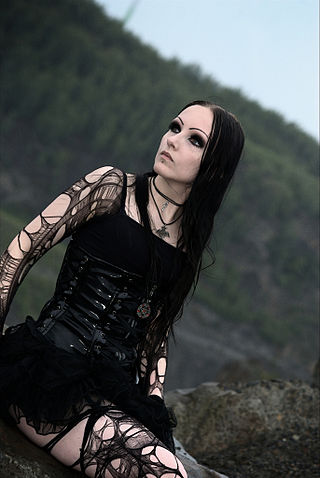
Dark culture, also called dark alternative scene, includes goth and dark wave culture, the dark neoclassical/dark ambient scene, parts of the post-industrial scene parts of neofolk and the early gothic metal scene. Dark culture's origin lies in followers of dark wave and independent music, but over the decades it has developed to a social network held together by a common concept of aesthetics, self-representation, and individualism. The musical preferences of the dark scene are characterized by a mix of styles ranging from futurism, electropop, early music, (neo-) classical, and folk music to punk rock, rock, techno and ambient music.

The fashion of the 2000's is often described as a global mash up, where trends saw the fusion of vintage styles, global and ethnic clothing, as well as the fashions of numerous music-based subcultures. Hip-hop fashion generally was the most popular among young people of all sexes, followed by the retro inspired indie look later in the decade.
The Toronto goth scene, the cultural locus of the goth subculture in Toronto, Ontario, Canada and the associated music and fashion scene, has distinct origins from goth scenes of other goth subcultural centres, such as the UK or Germany. Originally known as the "Batcavers", the term "goth" appeared only after 1988, when it was applied to the pre-existent subculture. Distinctive features included internationally recognized gothic and vampiric fashion store 'Siren', a goth-industrial bar named 'Sanctuary: The Vampire Sex Bar', and Forever Knight, a television series about an 800-year-old vampire living in Toronto. In Toronto, the goths did not seek to reject mainstream status, and achieved partial acceptance throughout the mid to late 1990s.

Street style is fashion that is considered to have emerged not from studios, but from the population at large. Street fashion is generally associated with youth culture, and is most often seen in major urban centers. Magazines and newspapers commonly feature candid photographs of individuals wearing urban, stylish clothing. Mainstream fashion often appropriates street fashion trends as influences. Most major youth subcultures have had an associated street fashion. Street style is different all around the globe.
